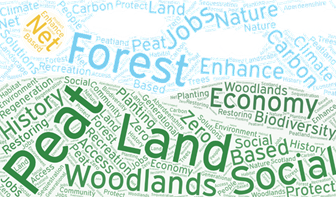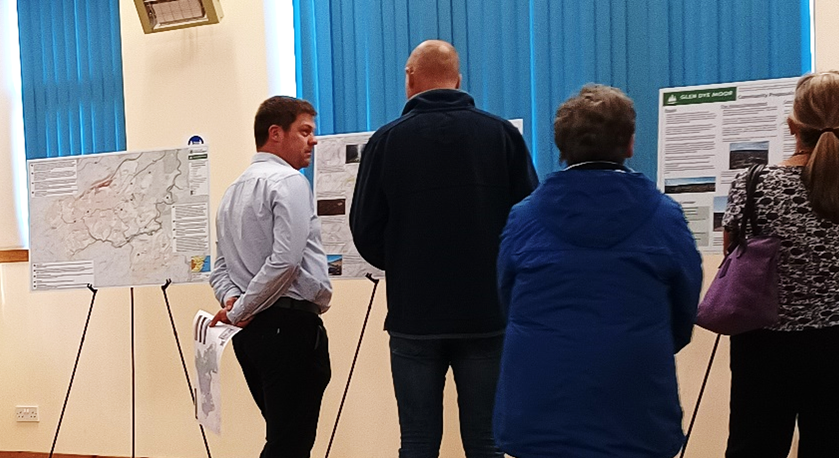Community Engagement at Scottish Woodlands
During national lockdowns, local forests were rediscovered by many community members as a forgotten escape right at their doorstep. This connection and familiarity with the forests has been intensified through the climate emergency which refocused attention on forests as part of the solution toward NetZero and a greener agenda. Recent land reform movements have also raised the profile of forest ownership in an effort to provide a more transparent view into forest ownership and community buy-in. Forest Manager and Chartered Surveyor Lorna Stewart working the Dingwall office noted “Community engagement is a key focus of the forthcoming Land Reform legislation. The reforms seek to increase transparency surrounding land ownership in Scotland and the way it is managed.” The spotlight has truly turned to forestry in Scotland and now more than ever people are engaging with forests.

Word cloud created from forestry consultation exercises
As a result of increased attention, the forest industry recognises a need to raise the standard of how it engages with people. Long gone are the days when putting up a sign was enough to satisfy a largely disinterested or stand-offish community. Forestry projects require carefully choreographed, inclusive, and dynamic approaches to engagement with an ever more informed and highly motivated public.

Artwork used for public engagement posters created by Scottish Woodlands Carbon Manager Emma Kerr to convey carbon sequestration
Early-stage public engagement is critical to woodland planning, landowner objectives are polished into a well-balanced design taking into account the local social setting resulting in a more successful project overall. This is especially true for privately owned land where objectives are owner-led and feedback from community engagement is vital to ensure opportunities are not missed in the forest design.
Scottish Woodlands has been hard at work rethinking public engagement in the forestry sector. As part of the company’s graduate training programme, new staff are given focused training modules to aid in planning for public engagement. Led by key industry groups such as Confor, Scottish Woodlands has also been participating in a pilot stakeholder engagement training course aiming to develop an industry wide programme to promote a more open and transparent culture within the industry when it comes to public engagement.
This training and industry wide collaboration work is designed to improve how the company engages with the public for a variety of projects ranging from rewilding to commercial forest planning. Tools are provided for managers to think holistically about each project and the unique social and cultural setting within which they sit. Engagement can then be designed to provide the best outcomes in terms of community participation. The company is using a variety of techniques including QR codes on signs, project specific websites and online materials, public drop-in sessions, village hall meetings, site tours, and focused engagement with interest groups. The overall aim is to identify opportunities where project design can be shaped to minimise negative impacts and maximise positive outcomes. One example of this currently in development is Glen Dye Moor, a new woodland creation site. Every year, the local Scout troop visits Glen Dye Moor for a camp-out. The area where the Scouts camp is currently open land with no forest cover. Following discussions with the troop leaders, this informal camping area will be planted with low density trees at targeted locations to provide future shelter and opportunity for hammocks to be used once the trees are full grown. This small change to the design of the new woodland produces a positive outcome resulting in mutual benefits. Scottish Woodlands are doing more to replicate this type of constructive engagement across all of our projects. Engaging with the public doesn’t always result in big forest design changes, but it can result in meaningful ones.

SWL Director Neil Crookston speaking with community members about a forestry project
As Scottish Woodlands continues to promote public engagement skills amongst its staff, more direct engagement with communities continues. Public knowledge about forestry varies and as one of the largest forest management firms in Scotland, the company strives to increase public awareness and knowledge about the forestry sector. Charles Gittins, Senior Forest Manager worked with a group of primary schools, local to the Chirk office, to organise the planting of trees by pupils as part of the Queen’s Green Canopy. He noted, “the activities highlighted the importance of trees in the locality, complemented the school syllabus and will encourage the pupils to monitor and maintain the trees.” Projects like this ensure not only that we share knowledge, information, and experiences with the next generation, but also ensure that we remain a part of the community with which we engage. Many of our managers live locally to where they work, and the communities they engage with are the same communities they are a part of.